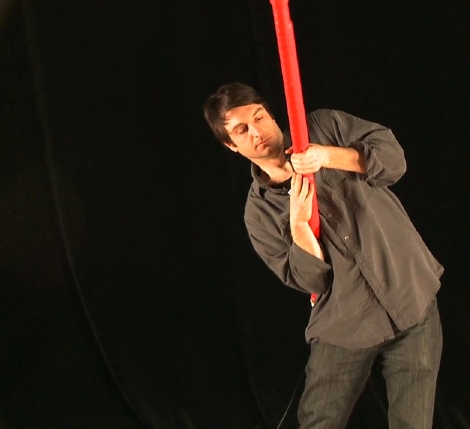D. Andrew Stewart (Bio)
Andrew Stewart's educational background includes his time at the Institute of Sonology in The Hague, Holland. While in The Netherlands, he completed post-graduate studies in composition with Louis Andriessen and Martijn Padding, and also trained in electroacousitc composition with Gilius van Bergeijk, Clarence Barlow and Paul Berg. Andrew then moved to France, where he developed his SonicJumper gestural controller with the assistance of Emmanuel Fléty and Suguru Goto (IRCAM, Paris, France); and continued working as a composer and performer. Andrew also holds degrees in music from The University of British Columbia (advisor: Keith Hamel) and Wilfrid Laurier University (advisor: Glenn Buhr). He is currently completing his final year of doctoral studies with John Rea and Sean Ferguson, at McGill University.
Andrew Stewart has received awards for several of his compositions, which have been featured in countries, such as: The Netherlands, The United States, Germany, France, Mexico, Austria, Italy and his home-country of Canada. Out of his more memorable experiences, the composer remarks upon his 2004 tour with the L'Orchestre National d'Harmonie des Jeunes performing his TROMBONE in southern France and conducting his Natural Distortions for the American College Band Directors National Association, in 1997. Both of these experiences involved working with young musicians projects that paralleled Andrew's activities in music education with the Dutch artists' collective Concerten Tot en Met, which he co-founded during a stay in The Netherlands (1996-1999). Andrew Stewart's residencies include: the Casalmaggiore International Festival, Italy; the composers' course in Radziejowicach, Poland (ISCM); the Tanglewood Music Center's summer session, in which the sheer ferocity (i.e. raw vocal techniques and decibel level) of a performance of his The ART of Japanese Bed-fighting caused babies to scream and the elderly to rock in their seats; R. Murray Schafer's AND WOLF SHALL INHERIT THE MOON, in which he has participated for ten years. Finally, Andrew was rewarded with excellent performances of his on tour, during a 2004 trip across Canada with L'Ensemble contemporain de Montréal, as part of their Génération project.
Andrew Stewart held an instructorship in Digital Studio Composition -an undergraduate course in electronic music composition- for the first four years of his doctoral studies, at McGill University. His training at the university has been centred on both acoustic instrument composition and advanced uses of gestural controller technology in the context of a music concert; thus, it has been an enriching environment to further develop his SonicJumper body-suit, which he currently uses to facilitate the creative act of composing music. Instead of making musical sketches at the piano, Andrew is typically wired up to sound and "conquering time", as Hugh Le Caine put it.
Andrew Stewart's research interests centre on the application of new technology both in the context of the classroom and the concert hall. His research can be classified into three primary areas:
- Developing class curricula and course design methods that focus on student learning. He encourages independent learning such that students gain the ability to teach themselves. The skill to teach oneself is highly desirable in the mercurial, ever-changing, domain of technology. Working in this field requires one who is self-reliant and adaptable while at the same time capable of applying an appropriate method of learning in order to stay ahead of the "technology curve".
- Interdisciplinary research that integrates music composition, performance and technology, addressing such issues as: real-time software systems design and implementation; digital instrument / controller design; human-computer interaction; gestural-controlled audio systems; gesture / sound mapping strategies.
- Blending acoustic and electronic music composition. The goal is to create music for live musicians, who are accompanied by a computer that makes musical decisions in real-time. In these cases, traditional aspects of melody, harmony and rhythm are being redeployed in relation to frequency, spectra and behavioural characteristics of the wide open sound world of electronics.

© 2008-19, Digital Composition Studios. All rights reserved. Design-Richard McKenzie, inspired by GetTemplate DCS logo- Eliot Britton/Richard McKenzie, DCS doodle David Adamcyk
 Digital Composition Studios
Digital Composition Studios  Home
Home